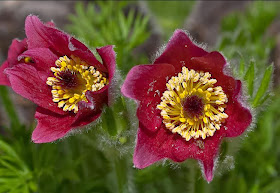Type of Flowers
Pulsatilla:
The genus Pulsatilla contains about 33 species of herbaceous perennials native to meadows and prairies of North America, Europe, and Asia. Common names include pasque flower (or pasqueflower), wind flower, prairie crocus, Easter Flower, and meadow anemone. Several species are valued ornamentals because of their finely-dissected leaves, solitary bell-shaped flowers, and plumed seed heads. The showy part of the flower consists of sepals, not petals.
The genus Pulsatilla is sometimes considered a subgenus under the genus Anemone.
The flower blooms early in spring, which leads to the common name Pasque flower, since Pasque refers to Easter (Passover).
Pulsatilla patens is the provincial flower of Manitoba, Canada and (as P. hirsutissima) is the state flower of South Dakota, United States.Pulsatilla vulgaris is the County flower for both Hertfordshire and Cambridgeshire in England.Pulsatilla vernalis is the county flower of Oppland, Norway.
Pulsatilla is highly toxic, and produces cardiogenic toxins and oxytoxins which slow the heart in humans. Excess use can lead to diarrhoea, vomiting and convulsions, hypotension and coma.It has been used as a medicine by Native Americans for centuries. Blackfoot Indians used it to induce abortions and childbirth. Pulsatilla should not be taken during pregnancy nor during lactation. Extracts of Pulsatilla have been used to treat reproductive problems such as premenstrual syndrome and epididymitis. Additional applications of plant extracts include uses as a sedative and for treating coughs. It is also used as an initial ingredient in homeopathic remedies.















No comments:
Post a Comment